当前位置:网站首页>Loss function in pytorch multi classification
Loss function in pytorch multi classification
2022-07-03 05:49:00 【code bean】
Preface
pytorch Loss function in :
- CrossEntropyLoss
- LogSoftmax
- NLLLoss
Softmax
In multi classification , We want the output to conform to the probability distribution , So the use of Softmax Normalized .

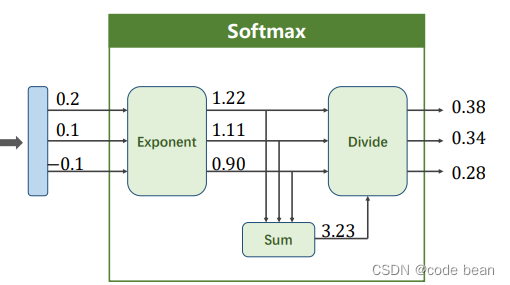
This process is very understandable , Add all the terms to get the denominator , Each is acting as a molecule , Just add one here e The exponential function at the bottom , Ensure that the values are greater than 0.
The last layer of multi classification neural network , It is usually used Softmax, So the last layer generally does not need to be activated ( See the code of the last numerical classification for details ), because Softmax It is equivalent to activation ( Map data to 0~1). Final Softmax Output the probability value of each category .
CrossEntropyLoss <==> LogSoftmax + NLLLoss
With the probability value , Start to construct the loss function , Cross entropy is still used here .
Maximum likelihood estimation , The divergence , Cross entropy _code bean The blog of -CSDN Blog

Recall the cross entropy of binary classification : Our function at that time BCE

criterion = torch.nn.BCELoss(size_average=True) # Two class cross entropy loss function This is the expansion of the formula above ,p=y q=(1-y) and Y There are only two options 0 and 1, So when Y be equal to 1 When , The latter one is gone . So when it comes to multi classification, it's actually the same ,Y There are only two options 0 and 1. When a certain category is 1 Then other classes are 0.( The categories here are mutually exclusive , There will be this feature , If you are a cat, you won't be a dog )
Cross entropy formula , Finally, there is only one item saved .
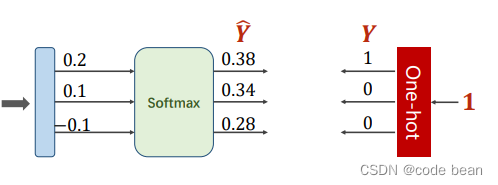
The single hot code on the right , It is the label of human judgment , It is also the probability given by people . Finally, there is only one term of mutually exclusive multi classification cross entropy :

LogSoftmax
that LogSoftmax The meaning of is to softmax The result of takes a log

m = nn.LogSoftmax()
input = torch.randn(2, 3)
output = m(input)Why is the probability of good output , Add another one log what are you doing? ?
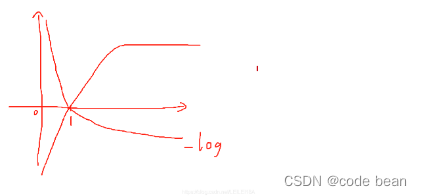
There is a saying that , Because the probability of output is 0~1, from log The function shows that , If the probability is closer 1, So it corresponds to Y The smaller the absolute value of . The greater the certainty of this representation , The less information , On the contrary, the greater the amount of information .
Then I think there is another reason , Namely LogSoftmax Generally and NLLLoss Used in combination with .
NLLLoss
NLLLoss What is done is the cross entropy part :


and NLLLoss The required input value is the result of logarithm of probability , that LogSoftmax and NLLLoss You can link seamlessly :
m = nn.LogSoftmax(dim=1)
loss = nn.NLLLoss()
# input is of size N x C = 3 x 5
input = torch.randn(3, 5, requires_grad=True)
# each element in target has to have 0 <= value < C
target = torch.tensor([1, 0, 4])
output = loss(m(input), target)
output.backward()CrossEntropyLoss
So much for that ,CrossEntropyLoss Do all the work of several people :

import torch
y = torch.LongTensor([0])
z = torch.Tensor([[0.2, 0.1, -0.1]])
criterion = torch.nn.CrossEntropyLoss()
loss = criterion(z, y)
print(loss)
An example of multi classification of number recognition
Finally, take a look at a detailed example , Specific usage 
import torch
from torchvision import transforms
from torchvision import datasets
from torch.utils.data import DataLoader
import torch.optim as optim
import torch.nn.functional as F
# Prepare the dataset
batch_size = 64
transform = transforms.Compose([transforms.ToTensor(), transforms.Normalize((0.1307,), (0.3081,))])
train_dataset = datasets.MNIST(root='./dataset/mnist/', train=True, download=True, transform=transform)
train_loader = DataLoader(train_dataset, shuffle=True, batch_size=batch_size)
test_dataset = datasets.MNIST(root='./dataset/mnist/', train=False, download=True, transform=transform)
test_loader = DataLoader(test_dataset, shuffle=False, batch_size=batch_size)
# Construct a network model
class Net(torch.nn.Module):
def __init__(self):
super(Net, self).__init__()
self.l1 = torch.nn.Linear(784, 512)
self.l2 = torch.nn.Linear(512, 256)
self.l3 = torch.nn.Linear(256, 128)
self.l4 = torch.nn.Linear(128, 64)
self.l5 = torch.nn.Linear(64, 10)
def forward(self, x):
# take C*W*H The three-dimensional tensor becomes the two-dimensional tensor , For deep learning processing
x = x.view(-1, 784)
x = F.relu(self.l1(x))
x = F.relu(self.l2(x))
x = F.relu(self.l3(x))
x = F.relu(self.l4(x))
# The last layer is not activated , No nonlinear transformation
return self.l5(x)
model = Net()
# Construct loss function and optimizer
criterion = torch.nn.CrossEntropyLoss() # This function , An inactive input is required , It will Cross entropy and softmax The calculation of .( This calculation is faster and more stable !)
optimizer = optim.SGD(model.parameters(), lr=0.01, momentum=0.5) # momentum: impulse
def train(epoch):
running_loss = 0
for batch_idx, data in enumerate(train_loader, 0):
# Get the input and label of a batch
inputs, target = data
# Start training
optimizer.zero_grad()
# Positive communication
y_pred = model(inputs)
# Calculate the loss
loss = criterion(y_pred, target)
# Back propagation
loss.backward()
# Update gradient
optimizer.step()
running_loss = running_loss + loss
if batch_idx % 300 == 299:
print('[%d, %5d] loss: %.3f' % (epoch + 1, batch_idx + 1, running_loss / 300))
running_loss = 0.0
def test():
correct = 0
total = 0
# Don't calculate the gradient
with torch.no_grad():
for data in test_loader:
inputs, labels = data
prec = model(inputs)
'''
torch.max(input, dim) function
Input :
input yes softmax One of the outputs of the function tensor
dim yes max The dimension of the functional index 0/1,0 Is the maximum per column ,1 Is the maximum per line
Output :
The function returns two tensor, first tensor Is the maximum per line ,softmax The largest of the outputs is 1,
So the first one tensor It's all. 1 Of tensor; the second tensor Is the index of the maximum value per row , The value of this index is exactly equal to the predicted number .
'''
_, predicted = torch.max(prec.data, dim=1) # predicated Dimensionality (784,1) Tensor
total += labels.size(0)
# Comparison between tensors
correct += (predicted == labels).sum().item()
print('accuracy on test set: %d %% ' % (100 * correct / total))
if __name__ == "__main__":
for epoch in range(10): # After each round of training , Predict once
train(epoch)
test()
Output results :
[1, 300] loss: 2.166
[1, 600] loss: 0.820
[1, 900] loss: 0.422
accuracy on test set: 89 %
[2, 300] loss: 0.306
[2, 600] loss: 0.269
[2, 900] loss: 0.231
accuracy on test set: 94 %
[3, 300] loss: 0.185
[3, 600] loss: 0.172
[3, 900] loss: 0.152
accuracy on test set: 95 %
[4, 300] loss: 0.129
[4, 600] loss: 0.124
[4, 900] loss: 0.118
accuracy on test set: 96 %
[5, 300] loss: 0.103
[5, 600] loss: 0.094
[5, 900] loss: 0.095
accuracy on test set: 96 %
[6, 300] loss: 0.080
[6, 600] loss: 0.076
[6, 900] loss: 0.077
accuracy on test set: 97 %
[7, 300] loss: 0.062
[7, 600] loss: 0.067
[7, 900] loss: 0.059
accuracy on test set: 97 %
[8, 300] loss: 0.052
[8, 600] loss: 0.050
[8, 900] loss: 0.051
accuracy on test set: 97 %
[9, 300] loss: 0.036
[9, 600] loss: 0.045
[9, 900] loss: 0.042
accuracy on test set: 97 %
[10, 300] loss: 0.031
[10, 600] loss: 0.034
[10, 900] loss: 0.032
accuracy on test set: 97 % Reference material :
《PyTorch Deep learning practice 》 Complete the collection _ Bili, Bili _bilibili
softmax Why should cross entropy be taken -log_LEILEI18A The blog of -CSDN Blog _ Cross entropy log
边栏推荐
- 2022.6.30DAY591
- Troubleshooting of 32GB Jetson Orin SOM failure to brush
- 期末复习DAY8
- "C and pointer" - Chapter 13 function pointer 1: callback function 2 (combined with template to simplify code)
- Redhat7系统root用户密码破解
- [teacher Zhao Yuqiang] Alibaba cloud big data ACP certified Alibaba big data product system
- [teacher Zhao Yuqiang] MySQL high availability architecture: MHA
- 1. 两数之和
- How to use source insight
- kubernetes资源对象介绍及常用命令(五)-(ConfigMap)
猜你喜欢

Export the altaro event log to a text file
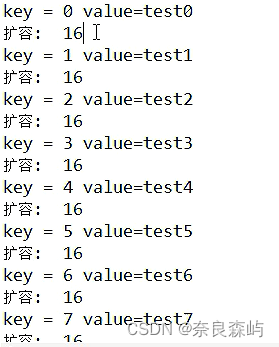
Capacity expansion mechanism of map

为什么网站打开速度慢?
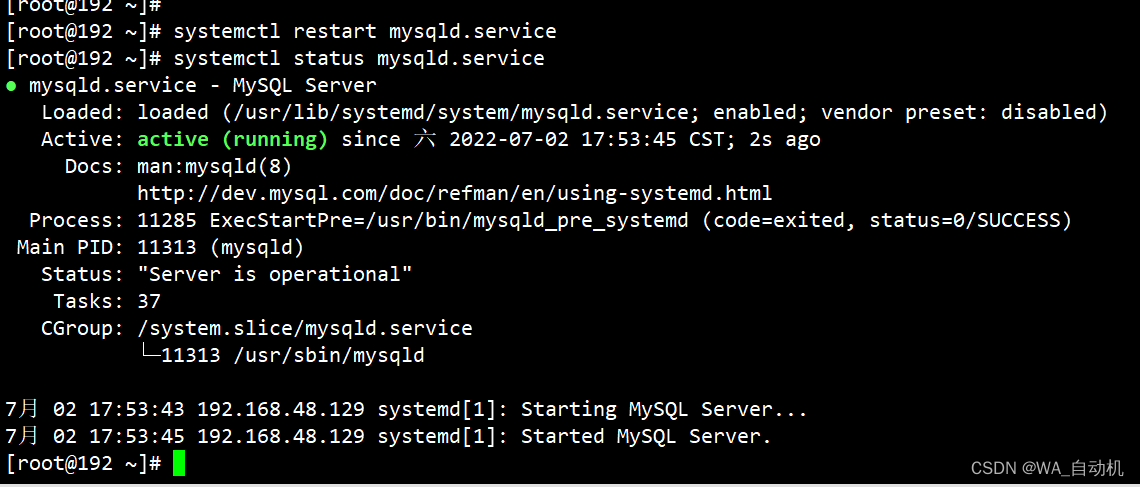
Linux登录MySQL出现ERROR 1045 (28000): Access denied for user ‘root‘@‘localhost‘ (using password: YES)

PHP notes are super detailed!!!

Qt读写Excel--QXlsx插入图表5

【一起上水硕系列】Day 10

Notepad++ wrap by specified character

【一起上水硕系列】Day 7 内容+Day8
![[together Shangshui Shuo series] day 7 content +day8](/img/fc/74b12addde3a4d3480e98f8578a969.png)
[together Shangshui Shuo series] day 7 content +day8
随机推荐
[teacher Zhao Yuqiang] index in mongodb (Part 1)
Source insight automatic installation and licensing
pytorch DataLoader实现miniBatch(未完成)
ansible防火墙firewalld设置
【一起上水硕系列】Day 7 内容+Day8
1. 兩數之和
The request database reported an error: "could not extract resultset; SQL [n/a]; needed exception is org.hibernate.exception.sqlgram"
期末复习(Day5)
伯努利分布,二项分布和泊松分布以及最大似然之间的关系(未完成)
【无标题】
今天很多 CTO 都是被幹掉的,因為他沒有成就業務
"C and pointer" - Chapter 13 function pointer 1: callback function 2 (combined with template to simplify code)
Communication - how to be a good listener?
MySQL 5.7.32-winx64 installation tutorial (support installing multiple MySQL services on one host)
[minesweeping of two-dimensional array application] | [simple version] [detailed steps + code]
Jetson AgX Orin platform porting ar0233 gw5200 max9295 camera driver
Strategy pattern: encapsulate changes and respond flexibly to changes in requirements
[explain in depth the creation and destruction of function stack frames] | detailed analysis + graphic analysis
redis 无法远程连接问题。
Altaro set grandfather parent child (GFS) archiving